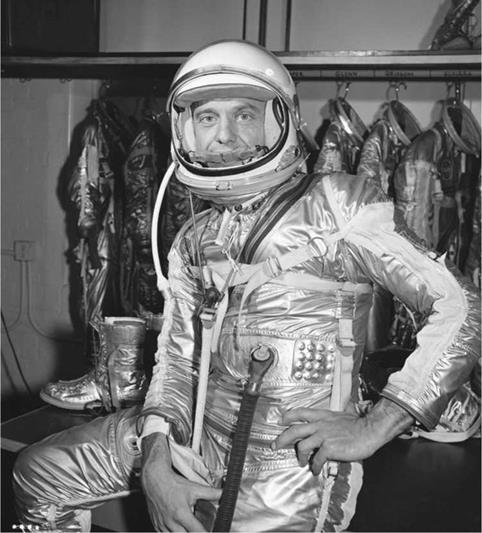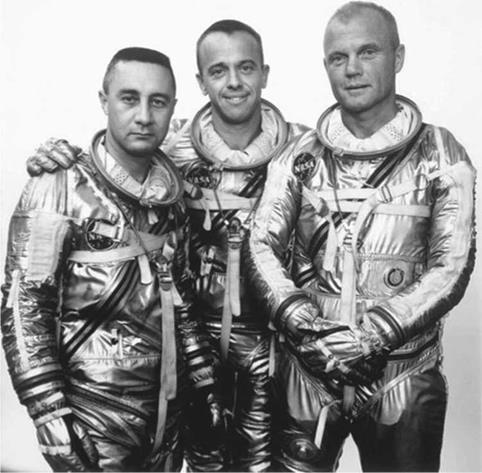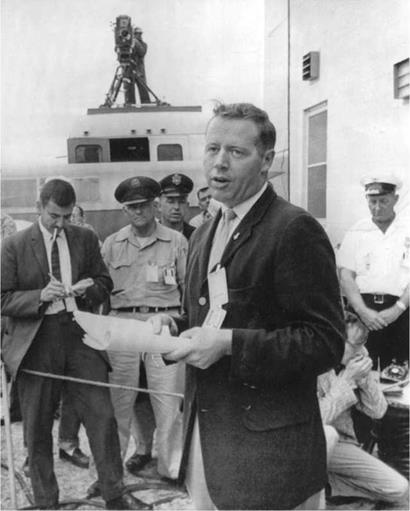DIMINISHING CHANCES
Despite the ominous weather, flight preparation work continued at Pad 5. As backup pilot, John Glenn realized that there was no immediate prospect of replacing a fit and ready Shepard on the flight, even if the storm abated. He eluded the waiting press and headed off to the pad to assist in preparing Freedom 7.
Meanwhile, Shepard, remaining in Hangar S, was informed that two ten-minute pauses had occurred in the lengthy countdown in order to assess weather reports. On the nominal schedule, he was to make the three-mile-long journey by transfer van to the pad at 4:00 a. m., but that time came and went, and soon he was watching the first pink tendrils of dawn tinting the gray clouds in the eastern sky. With no word from the weather people, Shepard was coming to the realization that the squall line, which lay ahead of a cold front stretching from Virginia to the Gulf coast, would probably prevent a launch that day.
“I frankly didn’t think we would go that morning. I wasn’t trying to second-guess anyone, but the weather did not look good at all. I was sure we wouldn’t get the results we needed, even if we did go. But the crews were ahead on the countdown, and if we didn’t try that morning we would have to go through a long 48-hour delay before we could refuel the Redstone and try again.” [3]
|
A fully suited Alan Shepard bides his time, waiting to fly. (Photo: NASA) |
Outside, a small group of authorized reporters and photographers representing the vast media army gathered at the Cape were also checking their watches, anxious for something to happen. For some, their main objectives were to photograph or film the space-suited astronaut leaving the hangar for the transfer bus, and the reporters were eager to communicate every move back to their editors. What everyone wanted to know, was which one of the three nominated astronauts was going to fly? NASA had still not announced whether it would be Glenn, Grissom, or Shepard, but the betting was on the affable Marine, John Glenn.
Then, suddenly, it was all over for that day; two storm fronts were converging on the Cape and down along the 290 miles of the Atlantic Missile Range over which the Redstone would fly. As the decision came, Shepard was standing just inside the door
|
The public could only speculate on which of the three main candidates would fly the MR-3 mission. (Photo: NASA) |
of the hangar, seconds away from going out to the transfer van. He was disheartened by the news, but not surprised. The launch had been postponed for at least two days. NASA needed clear visibility for the mission, especially in the critical first minutes, because the flight controllers would require good visual tracking in order to be ready to trigger Shepard’s escape mechanism at the first hint of trouble. That, they decided, was not going to be the case.
At 7:40 a. m., just 2 hours 20 minutes before the planned liftoff, an announcement came over loudspeakers that the shot had been postponed. “No new launch date has been set, but the minimum recycle time is 48 hours. The pilot will remain in the crew quarters in the Mercury hangar here.”
|
NASA’s Chief of Public Information, John (‘Jack’) King officially informs media representatives that the MR-3 flight has been scrubbed. (Photo: Associated Press) |
After Shepard had doffed his spacesuit, he was given a small glass of brandy to help him over his disappointment. “He didn’t really need it,” according to Lt. Col. John (‘Shorty’) Powers, NASA’s Public Affairs Officer. “There were about nine of us there who needed it more than he did. He just joined us.” [4]













